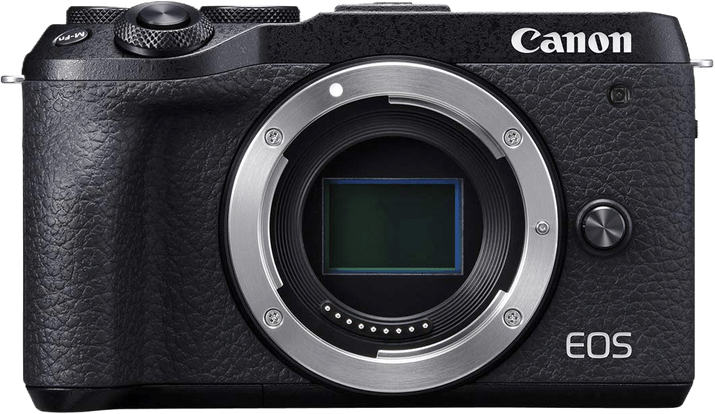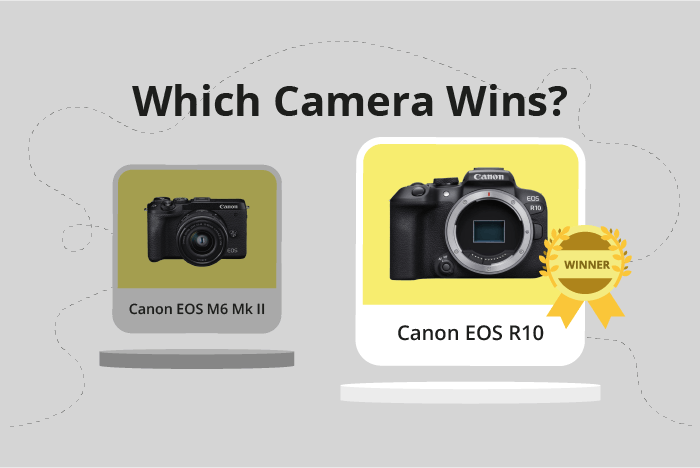Canon EOS M6 Mark II vs EOS R10 Comparison
Canon EOS M6 Mark II

Canon EOS R10

The Canon EOS R10 tops the competition with a score of 69/100, while the Canon EOS M6 Mark II follows closely with 63/100. Both cameras are mirrorless and share similar launch prices, with the R10 at $980 and the M6 Mark II at $850. Their sizes are also comparable, with the R10 measuring 123 x 88 x 83mm and weighing 426g, and the M6 Mark II at 120 x 70 x 49mm and 408g.
The Canon EOS R10’s higher score highlights its superior features, which justify the slightly higher price. As a newer model released in 2022, it offers more advanced technology and better performance. On the other hand, the Canon EOS M6 Mark II, released in 2019, is still a solid option with a lower price tag and lighter weight, making it ideal for budget-conscious consumers and those who prioritize portability.
Taking these factors into account, the Canon EOS R10 is the better choice for those seeking top-notch performance and updated technology, while the Canon EOS M6 Mark II remains a viable alternative for those with budget and portability concerns.
Canon EOS M6 Mark II vs EOS R10 Overview and Optics
The Canon EOS R10 outperforms the Canon EOS M6 Mark II in optics, scoring 71 out of 100 compared to the M6 Mark II’s score of 62. Both cameras share several specifications, including a CMOS sensor, an APS-C sensor size, and a lack of image stabilization. However, the R10 has a superior processor, lens mount, and DXOMARK score, while the M6 Mark II boasts a higher megapixel count.
The R10’s advantages stem from its Digic X processor, which allows for faster and more efficient image processing. Additionally, the R10’s Canon RF lens mount offers a wider range of compatible lenses, providing users with more flexibility in their photography. The most significant difference, though, is the R10’s impressive DXOMARK score of 97, which indicates a higher-quality sensor that delivers better image quality and low-light performance than the M6 Mark II’s score of 58.
On the other hand, the M6 Mark II has a higher megapixel count of 33, compared to the R10’s 24 megapixels. This results in larger and more detailed images that can be more easily cropped or printed at larger sizes. The M6 Mark II also has a slightly faster shooting speed of 14 frames per second, compared to the R10’s 15 frames per second, which might be beneficial for capturing fast-moving subjects.
Despite these advantages, the Canon EOS R10’s superior processor, lens mount, and sensor quality make it the better choice for photographers seeking optimal optical performance. While the M6 Mark II’s higher megapixel count and shooting speed may be appealing to some, the R10’s overall better performance in optics ensures higher image quality and versatility in various shooting conditions.
Canon EOS M6 Mark II vs EOS R10 Video Performance
When comparing the video capabilities of the Canon EOS M6 Mark II and the Canon EOS R10, both cameras come out as winners with identical scores of 91 out of 100. This high score reflects their excellent video performance and advanced features.
Both cameras boast a maximum video resolution of 4K and dimensions of 3840 x 2160, ensuring that users can capture high-quality, detailed footage. Additionally, they each offer a maximum video frame rate of 120fps, ideal for capturing fast-paced action and smooth slow-motion shots. Both cameras also come equipped with built-in time-lapse functionality, allowing for creative and dynamic time-lapse videos without the need for additional equipment or software.
Although the Canon EOS M6 Mark II and EOS R10 share the same video specifications, each camera has its own unique strengths. The M6 Mark II’s compact size and lightweight design make it an ideal choice for vloggers and content creators who require a portable and versatile camera for on-the-go shooting.
On the other hand, the EOS R10, as a full-frame camera, may offer better low-light performance and a wider dynamic range, making it more suitable for professional videographers who require the highest possible image quality. However, it is essential to consider that the size and weight of the EOS R10 may be less convenient for some users.
In comparing the video capabilities of the Canon EOS M6 Mark II and the Canon EOS R10, it is clear that both cameras excel in this area, offering high-quality 4K video, fast frame rates, and time-lapse functionality. The choice between the two ultimately depends on individual preferences and shooting requirements, with the M6 Mark II being more portable and the EOS R10 potentially offering superior image quality.
Canon EOS M6 Mark II vs EOS R10 Features and Benefits
The Canon EOS M6 Mark II and the Canon EOS R10 both have a feature score of 70/100. This shows that these cameras have similar capabilities in terms of their features. Both cameras share several specifications, making them quite comparable in this aspect.
The common specifications between the two cameras include a 3-inch screen size, a screen resolution of 1,040,000 dots, a touchscreen, a flip screen, no GPS, WIFI, and Bluetooth capabilities. These shared features make both cameras suitable for a variety of photography and videography needs.
However, it is essential to examine the unique aspects of each camera to determine which one is better. The Canon EOS M6 Mark II has a more compact design, making it easier to carry around and use in different situations. This advantage might be crucial for photographers who prioritize portability and ease of use.
On the other hand, the Canon EOS R10 offers a more robust build quality, which can be beneficial for those who require a more durable camera for challenging environments. This advantage may outweigh the compactness of the Canon EOS M6 Mark II for certain users.
Both cameras have their strengths and weaknesses. The Canon EOS M6 Mark II is more portable, while the Canon EOS R10 offers a more durable build. Ultimately, the choice between these cameras depends on the individual’s preferences and requirements. Regardless of the decision, both cameras provide a range of features that cater to various photography and videography needs.
Canon EOS M6 Mark II vs EOS R10 Storage and Battery
The Canon EOS R10 wins in the storage and battery category with a score of 40/100, while the Canon EOS M6 Mark II scores 35/100. Both cameras have one memory card slot and accept SD, SDHC, and SDXC memory cards. They also use the same LP-E17 battery type and support USB charging.
The EOS R10 outperforms the M6 Mark II in battery life, offering 450 shots compared to 305 shots. This longer battery life makes the R10 more suitable for extended shooting sessions. However, the EOS M6 Mark II has an advantage in memory card compatibility, supporting faster UHS-II cards, while the R10 only supports UHS-I cards. This means the M6 Mark II can potentially achieve faster write speeds and better performance with compatible memory cards.
Despite the M6 Mark II’s advantage in memory card compatibility, the EOS R10’s longer battery life makes it the superior choice for photographers who prioritize endurance in the field. Both cameras share common features in storage and battery, but the R10’s edge in battery life gives it the winning position in this comparison.
Canon EOS M6 Mark II vs EOS R10 – Our Verdict
Are you still undecided about which camera is right for you? Have a look at these popular comparisons that feature the Canon EOS M6 Mark II or the Canon EOS R10:

